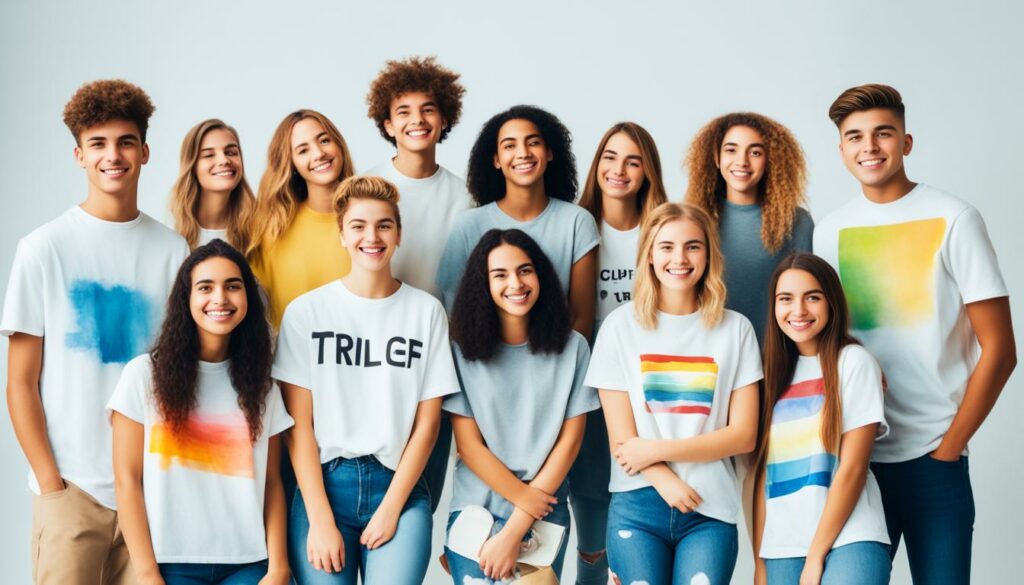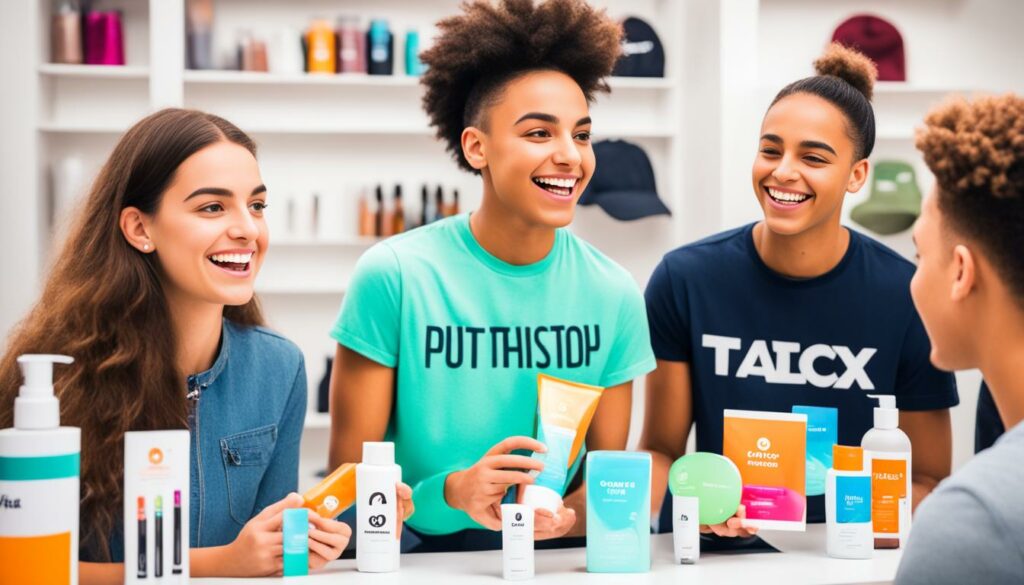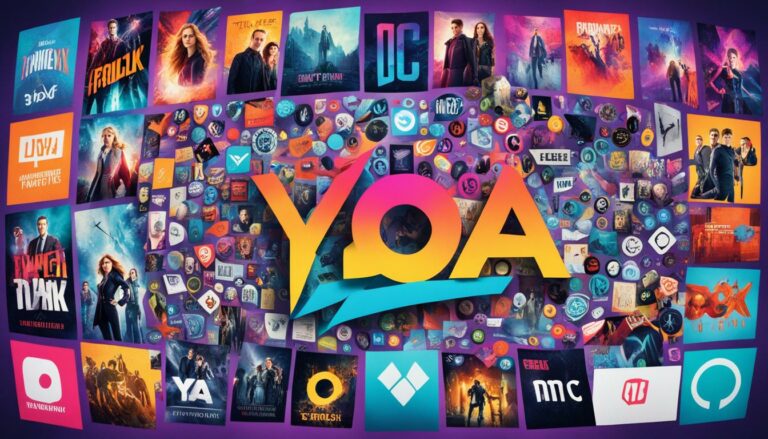Understanding What Teens Want – Insights & Trends
Marketing to teenagers requires a customized approach that aligns with their unique needs and behaviors. Traditional methods like commercials and billboards are no longer as effective as they once were. To successfully reach teens, businesses need to understand their desires and preferences, redefine demographics, and tap into their online behavior.
Teens today are obsessed with social media, constantly sharing information and seeking real-time content. They want to be involved, participate, and care about what others think. To effectively market to this generation, businesses should focus on meeting their needs, creating excitement, and utilizing platforms like YouTube and Facebook, where teens spend a significant amount of their time.
Key Takeaways:
- Teens have unique needs and behaviors that require a different marketing approach.
- Redefining demographics based on behavior insights is crucial for understanding and reaching teens.
- Social media platforms like YouTube and Facebook are essential for effectively marketing to teens.
- Creating excitement and focusing on meeting teens’ needs is key to successful marketing.
- Understanding the teen mindset and tapping into their desire for participation and involvement is crucial.
Redefining Teen Demographics

Traditionally, marketing to teenagers relied heavily on demographic information such as gender and socioeconomic status. However, to truly understand and reach teens, it is crucial to shift the focus towards behavior insights. By examining the way teens interact with technology and consume media, marketers can gain valuable insights into their preferences, needs, and desires.
Teens today are highly active on social media platforms, constantly discovering and sharing information with their peers. They prefer real-time content that keeps them engaged and involved, and they care deeply about the opinions of others. This behavior is indicative of the need for marketing strategies that align with their online behavior and values.
“By redefining demographics based on behavior insights, businesses can tailor their marketing efforts to meet the unique needs of teens.”
Understanding these behavior insights allows marketers to create targeted and relevant campaigns that speak directly to the interests and aspirations of teens. By effectively tapping into these insights, businesses can build strong connections with this demographic and establish a lasting brand relationship.
Benefits of Redefining Teen Demographics:
- Provides deeper understanding of teens’ online behavior and preferences
- Enables tailored marketing campaigns that resonate with teens’ needs and desires
- Allows businesses to create engaging and relevant content
- Establishes a genuine connection with teens, fostering brand loyalty
To illustrate the power of behavior insights in redefining teen demographics, let’s take a look at the following table:
| Traditional Demographics | Redefining Demographics based on Behavior Insights |
|---|---|
| Gender | Active on social media, prefer real-time content |
| Socioeconomic Status | Enjoy discovering and sharing information |
| Age | Want to participate and be involved |
| Location | Care about the opinions of others, seek validation |
This table clearly demonstrates how focusing on behavior insights allows businesses to tailor their marketing strategies to meet the unique needs and interests of teens. By redefining demographics beyond traditional categories, marketers can effectively engage with this demographic and build successful campaigns that resonate with their target audience.
Trends in Teen Online Use
When marketing to teenagers, it is crucial to understand the websites and apps they frequent. By staying updated on the latest trends in teen online use, businesses can effectively reach this demographic and tailor their marketing strategies accordingly.
A recent study revealed interesting insights into the online behavior of high school seniors. It found that popular websites like Buzzfeed or Gawker are not at the top of their online activity list. Instead, teenagers are highly active on social media platforms such as Facebook and Snapchat.
Moreover, teens have a strong affinity for video content, and platforms like YouTube are a vital part of their online experience. They spend a significant amount of time watching and engaging with videos on various topics.
Music also plays a crucial role in the lives of teenagers, with many using platforms like Pandora to discover new tunes and create personalized playlists.
To effectively connect with teens, businesses should focus their marketing efforts on these popular websites and apps. By establishing a strong presence on social media, creating engaging video content, and leveraging the power of music, companies can capture the attention and interest of teenage audiences.
| Popular Websites and Apps | Teen Usage |
|---|---|
| Highly active | |
| Snapchat | Highly active |
| YouTube | Extensively used for video content consumption and engagement |
| Pandora | Source of music discovery and playlist creation |
Tips for Marketing to Teenagers

When it comes to marketing to teenagers, it’s all about understanding their unique desires and preferences. To effectively connect with this audience, businesses can employ the following strategies:
- Create engaging and shareable content: Teens love to participate and be involved. By developing content that encourages interaction and sharing, businesses can tap into the immense power of word-of-mouth marketing.
- Address issues teens care about: To capture the attention of teenagers, it’s important to address topics that are relevant and meaningful to them. By understanding their interests and concerns, businesses can tailor their messaging to resonate with this demographic.
- Align with pop culture: Pop culture plays a significant role in the lives of teenagers. By incorporating references and trends from music, movies, and celebrities, businesses can make their marketing efforts more relatable and appealing to teens.
- Offer freebies or contests: Teenagers love a good deal or the chance to win something exciting. By offering freebies, discounts, or hosting contests, businesses can create a sense of excitement and exclusivity that resonates with this audience.
- Encourage independence: Teenagers are at a stage in their lives where they are seeking independence. By empowering them and providing opportunities for self-expression, businesses can forge a meaningful connection with teens.
- Use youth-friendly language: Teens have their own unique way of communicating, and businesses should speak their language. By using casual, conversational, and youth-friendly language in their marketing materials, businesses can build rapport with this audience.
- Tap into celebrity trends: Teenagers often look up to celebrities as role models and influencers. By leveraging popular celebrity trends and endorsements, businesses can capture the attention of teens and gain credibility among this demographic.
Furthermore, it is crucial to utilize platforms that teenagers frequent. Social media platforms like Facebook, YouTube, and Snapchat are especially popular among teens, so businesses should focus their marketing efforts on these channels. By creating engaging and trendy videos that align with the interests of teenagers, businesses can increase their chances of success in reaching this audience.
To illustrate these strategies, take a look at the following example:
“We are excited to announce the Teen Trendsetter Challenge! Show us your most innovative fashion creations inspired by your favorite celebrity trendsetter and get a chance to win a VIP shopping experience with a professional stylist. Share your designs on Instagram using #TeenTrendsetterChallenge and tag our brand for a chance to be featured on our social media channels. Join us in celebrating individuality and expressing yourself through style!”
By implementing these marketing tips and strategies, businesses can effectively connect with teenagers and create meaningful experiences that resonate with this dynamic and influential demographic.
Marketing to Teens: Important Things to Remember

When it comes to marketing to teenagers, it’s crucial to keep in mind that their preferences and interests can change rapidly. Today’s trends may be forgotten tomorrow, and businesses need to stay on top of the latest information to effectively reach this dynamic audience. Here are some important considerations for successful teen marketing strategies:
- Stay up-to-date: Teenagers are always looking for what’s new and exciting. Regularly updating marketing materials and campaigns is essential to capture their attention and maintain relevance. By being current with trends and fads, businesses can connect with teens on a deeper level and make a lasting impression.
- Post new content daily: Teenagers have short attention spans and crave fresh content. Whether it’s eye-catching pictures, captivating ads, or breaking news, businesses should strive to provide daily updates that keep teens engaged. By consistently offering something new, businesses can hold the attention of this tech-savvy generation.
Here’s an example of how regular updates and fresh content can be effective:
| Marketing Strategy | Result |
|---|---|
| Posting daily viral videos on YouTube | Increased brand visibility and engagement among teens |
| Launching new limited-edition products regularly | Creating a sense of exclusivity and driving demand among teens |
| Collaborating with popular teen influencers on social media | Expanding reach and credibility among a loyal teen following |
By continuously updating and tailoring marketing efforts to the ever-changing preferences of teenagers, businesses can navigate the fast-paced world of teen marketing and build lasting connections with this influential audience.
Decoding the Teen Mindset

Understanding the teen mindset is crucial for connecting with and resonating with teenagers. Today’s teens are members of the most culturally diverse generation, and culture plays a central role in their identities. They seek brands that align with their values, embrace diversity, and foster inclusivity.
One aspect of teen culture that holds significant importance is music. Music serves as a key vehicle for self-expression and cultural representation. In fact, 99% of teenagers listen to music regularly, making it a powerful tool for connecting with this demographic. By incorporating music into marketing strategies, brands can tap into the emotional resonance that music evokes in teens.
Another key characteristic of the teen mindset is a strong desire for content creation. Today’s generation of teens is actively engaged in creating content that goes viral and influences older generations. They crave the opportunity to express themselves creatively and make an impact through their digital presence.
To truly resonate with teenagers, brands should encourage and enable content creation among their teen audience. By providing platforms and opportunities for teens to showcase their creativity, brands can foster a sense of belonging and empowerment among this demographic.
“Today’s teens are not passive consumers; they are active participants in shaping the cultural landscape.”
The Power of Influencer Marketing
Influencer marketing has gained tremendous popularity among teenagers. Teens look up to influencers and seek their guidance and recommendations. Collaborating with relevant influencers can greatly enhance a brand’s ability to connect with teens and gain their trust.
When choosing influencers for teen marketing campaigns, it is essential to consider their authenticity, relatability, and alignment with the brand’s values. Teens can quickly discern inauthenticity, so it’s crucial to choose influencers who genuinely resonate with the target audience.
Building an Emotional Connection
Connecting with teens requires more than just understanding their interests and preferences. It requires building an emotional connection that goes beyond transactional experiences. Brands that can tap into the emotions, passions, and aspirations of teenagers will create lasting connections and loyalty.
One effective way to build an emotional connection is by supporting social causes that align with the values of teenagers. By actively participating in initiatives that promote positive change, brands show their commitment to making a difference in the world—a value that resonates strongly with today’s youth.
Case Study: Nike
Nike serves as a prime example of a brand that has successfully decoded the teen mindset. The company’s marketing campaigns emphasize inclusivity, diversity, and empowerment, aligning with the values of teenagers. Nike leverages music, cultural references, and powerful storytelling to connect emotionally with its teen audience.
For instance, Nike’s “Dream Crazy” campaign featuring Colin Kaepernick, a controversial figure in the realm of racial justice, resonated strongly with teenagers. The campaign not only sparked conversations but also connected with the core values and beliefs held by many young individuals.
| Key Strategies for Connecting with Teens | Example Brands |
|---|---|
| Embrace diversity and inclusivity | Ben & Jerry’s |
| Utilize music and cultural references | Spotify |
| Empower teens through content creation | TikTok |
| Support social causes | Patagonia |
The table above highlights key strategies for connecting with teens and provides examples of brands that have successfully implemented these strategies.
Teens and Social Media
Social media use by teens has become a topic of great interest in recent years. With concerns about the amount of time spent on screens, comparisons with others, cyberbullying, and exposure to radical views, the impact of social media on teenagers has been a subject of debate and study.
However, despite these concerns, overall, teens tend to view their experiences on social media as mostly positive. In fact, social media platforms provide them with a sense of connection, acceptance, and support. Through these platforms, teens feel connected to their friends, which plays a vital role in their social lives.
“Social media helps me stay connected with my friends, especially when we can’t meet up in person. It makes me feel like I’m part of a community.” – Jane, 16
Though there are positive experiences, teens also face challenges on social media. For some, the constant drama and conflict can be overwhelming, as they navigate through the complexities of online social dynamics. Additionally, some teens may experience feelings of exclusion or loneliness when they see their peers engaging in activities without them.
Gender differences also play a role in teens’ experiences on social media. Teen girls, in particular, are more likely to report negative experiences such as cyberbullying or body shaming. It is essential for businesses to understand and address these gender-specific challenges to effectively connect with this audience.
The Positive and Negative Sides of Social Media for Teens
On one hand, social media serves as a powerful tool for teens to express themselves creatively, explore their interests, and connect with like-minded individuals. Platforms like Instagram and YouTube allow them to showcase their talents and passions to a wider audience.
On the other hand, the negative effects of social media cannot be overlooked. Research has shown that spending excessive time on social media can lead to feelings of inadequacy, anxiety, and a distorted sense of reality. It is important for parents, educators, and businesses to encourage a balanced approach to social media use and promote healthy digital habits among teenagers.
The Role of Businesses in Navigating Teens’ Social Media Experiences
Businesses can leverage social media to effectively reach and engage with teens by understanding their experiences, concerns, and desires. By authentically connecting with this audience, businesses can build trust, deliver meaningful content, and establish a positive presence in the digital space.
Understanding the various positive and negative aspects of social media experiences for teens is crucial for businesses aiming to connect with this demographic. By recognizing and addressing the challenges, businesses can create strategies that not only resonate with teens but also provide a safe and positive online environment.
Positive Effects of Social Media on Teens
Despite concerns about social media, teenagers generally have positive experiences when using it. Social media platforms offer various benefits that contribute to their overall well-being and sense of belonging.
Connectedness through Social Media
Social media provides an avenue for teens to stay connected with their friends and peers, regardless of physical distance. Through platforms such as Facebook, Instagram, and Snapchat, teenagers can easily share updates, photos, and messages, fostering a sense of closeness and strengthening their relationships.
“Social media allows me to stay in touch with my friends, even when we can’t meet in person. It makes me feel connected to them and a part of their lives.” – Sarah, 16
This connectedness helps teenagers feel accepted and supported by their peers, which is crucial during their formative years. It provides a sense of community and reassurance that they are not alone in their experiences and challenges.
Creative Outlet for Teens
Social media platforms also serve as creative outlets for teenagers. They can showcase their talents, express themselves through art, music, or writing, and receive feedback and encouragement from their online communities.
Platforms like TikTok and YouTube allow teens to create and share their own videos, giving them a platform to unleash their creativity and find their voices.
“I love using social media to express myself. It’s a place where I can share my photos, artwork, and even writing. I receive so much positive feedback and inspiration from others, which motivates me to continue creating.” – Ethan, 15
Teens often find validation and recognition for their creative pursuits on social media, fostering a sense of accomplishment and building their self-confidence.
In summary, social media has positive effects on teens by promoting connectedness and providing a creative outlet. Platforms like Facebook, Instagram, TikTok, and YouTube allow teenagers to stay connected with friends, express themselves artistically, and receive support and validation. By understanding these positive effects, businesses can leverage social media to connect with teenagers and create meaningful experiences.
Negative Experiences on Social Media for Teens
While social media offers many positives for teenagers, it is not without its drawbacks. Some teens report negative experiences related to their social media use, which warrant attention and consideration. Two common concerns that arise are the amount of time spent on social media and its impact on social interactions.
Many teens express concerns about the excessive time they spend on social media platforms. They often feel addicted to these platforms, finding it difficult to disconnect and engage in other activities. This addiction can result in a lack of balance in their lives, with diminished time for real-life interactions, hobbies, and other essential aspects of personal well-being.
Furthermore, the impact of social media on social interactions is a significant concern for many teenagers. The online environment can breed feelings of isolation and loneliness, as teens substitute face-to-face interactions with digital connections. Some teens also experience a sense of inadequacy when comparing themselves to others on social media, as they navigate carefully curated images and narratives.
These negative experiences highlight the importance of addressing the concerns surrounding social media and finding ways to alleviate their impact on teens. It is crucial for businesses to recognize the influence of social media on teens’ lives and take responsible measures to promote a healthy balance between online and offline experiences.
Addressing Concerns and Promoting Balance
Businesses play a vital role in addressing the negative effects of social media on teens. By incorporating strategies that address concerns and promote balance, businesses can support healthy social media use among teenagers. Some effective approaches include:
- Encouraging offline activities and face-to-face interactions through campaigns and initiatives
- Promoting digital well-being and self-care practices through educational content
- Collaborating with influencers and experts who advocate for responsible social media use
By adopting these strategies, businesses can help teens develop a healthier relationship with social media, fostering their overall well-being and empowering them to make informed choices regarding their online habits.
| Concerns | Impact |
|---|---|
| Lack of balance due to excessive time spent on social media | Reduced engagement in real-life activities and limited social interactions |
| Feelings of addiction and dependence on social media | Diminished focus on personal well-being and neglect of other important aspects of life |
| Negative emotions arising from comparisons with others | Decreased self-esteem and heightened feelings of inadequacy |
Teens’ Views on the Impact of Social Media
When it comes to the impact of social media on teenagers, their views are somewhat divided. While many teens see social media as having mostly positive effects on themselves, they tend to be more skeptical about its impact on their peers. In fact, a significant number of teens believe that social media has neither a positive nor a negative effect on people their age.
The positive effects that teens attribute to social media include feeling more connected to their friends, experiencing a sense of acceptance and support, and having a creative outlet for self-expression. Teen girls, in particular, often find a stronger sense of creative expression and support through social media platforms.
“Social media has allowed me to connect with friends and share my thoughts and experiences with a wider audience. It also gives me a sense of belonging and support.”
However, it is important for businesses to understand that there are also negative experiences associated with social media use among teens. Concerns about the amount of time spent on social media and its impact on social interactions are common. Some teens express feelings of addiction to social media and a lack of social activity in real life.
Overall, while the opinions of teens may vary, businesses should consider these mixed views when developing their marketing strategies. It is crucial to ensure that the benefits of social media outweigh the concerns, and to create a safe and positive online environment for teens to engage with.
Key Takeaways:
- Teens generally see social media as mostly positive for themselves but have mixed views on its impact on their peers.
- Positive effects of social media on teens include feeling more connected, accepted, and supported, as well as providing a creative outlet.
- Negative experiences include concerns about time spent on social media and its impact on real-life social interactions.
- Businesses should consider these differing views when developing marketing strategies, ensuring that the benefits of social media outweigh the concerns.
Digital Privacy and Teens
While digital privacy continues to be a topic of concern, it seems that most teens are not particularly worried about the personal information collected by social media companies. They perceive their control over the data they share to be limited, but this lack of control doesn’t necessarily translate into significant distress.
These attitudes suggest that businesses should prioritize two key factors when it comes to collecting and using teens’ personal information: transparency and security. By fostering an environment of trust and ensuring the safeguarding of user data, businesses can alleviate the concerns surrounding digital privacy.
Transparency is crucial in gaining the trust of teens. When businesses are open and honest about the types of data collected, how it is used, and the precautions taken to protect it, teens feel more comfortable engaging with online platforms. This transparency can be achieved through clear and concise privacy policies and proactive communication efforts.
Security is another vital aspect. Businesses must employ robust security measures to protect teens’ personal information from unauthorized access or data breaches. By demonstrating a commitment to protecting user data, businesses can assure teens that their information is safe and instill confidence in the platforms they use.
By prioritizing transparency and security, businesses can address teens’ concerns about digital privacy and create a safer and more trustworthy online environment.
“Transparency and security are key in ensuring teens feel comfortable sharing their personal information on social media platforms.”
In summary, while teens may not express significant worries about digital privacy, it is important for businesses to take proactive steps to address their concerns. By implementing transparent practices and robust security measures, businesses can foster trust with teens and create a safer online space that respects their privacy.
| Key Considerations for Digital Privacy and Teens |
|---|
| 1. Transparency: Clearly communicate data collection practices and how personal information is used. |
| 2. Security: Implement stringent measures to protect user data from unauthorized access or breaches. |
| 3. Trust Building: Foster trust by proactively addressing concerns and communicating efforts to prioritize user privacy. |
Understanding and addressing teens’ concerns about digital privacy is essential for businesses aiming to build a positive reputation and establish a long-term relationship with teenage users. By prioritizing transparency and security, businesses can create a safer online environment that encourages teens to engage and share their personal information with confidence.
Conclusion
Understanding what teens want is crucial for successful marketing to this audience. By redefining demographics based on behavior insights and leveraging popular websites and apps, businesses can effectively connect with teenagers. Creating tailored content that resonates with their desires and preferences is key.
It is also important to acknowledge the positive and negative effects of social media on teens. While social media can provide a platform for connection and creativity, concerns about time spent online and digital privacy should be addressed. Balancing the online and offline experiences is essential to meet the needs of teens.
Furthermore, businesses should strive to understand the unique mindset of teenagers and embrace diversity. By providing meaningful experiences and creating content that aligns with their values and interests, brands can build strong connections with today’s youth.
In conclusion, understanding what teens want and tailoring marketing strategies accordingly is the key to successful teen marketing. By staying up-to-date with trends, leveraging technology and social media platforms, and creating engaging and relevant content, businesses can effectively reach and resonate with this important demographic.
FAQ
What is the best approach to marketing to teenagers?
The best approach to marketing to teenagers is to understand and meet their unique needs and behaviors, create excitement, and utilize platforms like YouTube and Facebook that teens frequent.
How can businesses redefine demographics to effectively market to teens?
Businesses can redefine demographics by focusing on behavior insights, such as teens’ active presence on social media, their preference for real-time content, their desire to participate and be involved, and their concern for others’ opinions.
Which websites and apps do teenagers use the most?
Teenagers are highly active on social media platforms like Facebook and Snapchat and frequently use YouTube for video content. They also enjoy platforms like Pandora for music.
What techniques should businesses use when marketing to teenagers?
Businesses should create content that asks for feedback, is shareable, addresses issues teens care about, aligns with pop culture, offers freebies or contests, encourages independence, uses youth-friendly language, taps into celebrity trends, and utilizes platforms like Facebook and YouTube.
How can businesses keep up with teenagers’ ever-changing preferences and interests?
Businesses should regularly update marketing materials and campaigns, posting new content daily to align with teenagers’ attention span and keep up with their need for the latest information.
What is the key to resonating with and connecting with teenagers?
The key to resonating with and connecting with teenagers is to understand their mindset, embrace diversity, incorporate music, encourage content creation, and provide meaningful experiences.
How do teenagers view their experiences on social media?
Overall, teenagers view their experiences on social media as mostly positive, feeling more connected to friends, accepted, and supported.
What are the positive effects of social media on teens?
The positive effects of social media on teens include feeling more connected to friends, accepted, supported, and having a creative outlet for self-expression.
What negative experiences do teens have on social media?
Negative experiences on social media for teens include feeling overwhelmed by drama and excluded by friends.
How do teens perceive the impact of social media on themselves and their peers?
Teens mostly view the impact of social media on themselves as positive, but they are more downbeat about its effect on teens in general, feeling that it has neither a positive nor negative effect.
Do teens worry about their privacy on social media?
Most teens do not worry about the personal information collected by social media companies, feeling they have little to no control over it but not overly concerned.
How can businesses effectively market to teenagers?
To effectively market to teenagers, businesses should understand their desires and preferences, redefine demographics based on behavior insights, tailor marketing materials to their interests, and address their concerns about social media and digital privacy.







